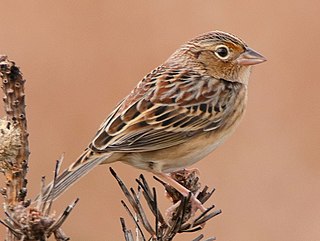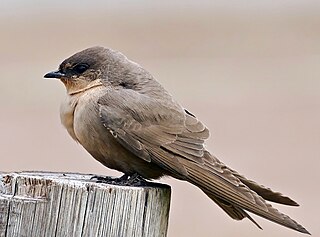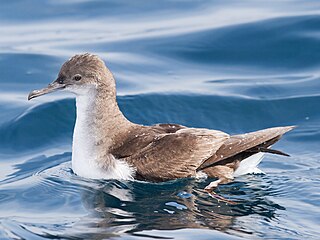
The killdeer is a large plover found in the Americas. It gets its name from its shrill, two-syllable call, which is often heard. It was described and given its current scientific name in 1758 by Carl Linnaeus in the 10th edition of his Systema Naturae. Three subspecies are described. Its upperparts are mostly brown with rufous fringes, the head has patches of white and black, and two black bands cross the breast. The belly and the rest of the breast are white. The nominate subspecies breeds from southeastern Alaska and southern Canada to Mexico. It is seen year-round in the southern half of its breeding range; the subspecies C. v. ternominatus is resident in the West Indies, and C. v. peruvianus inhabits Peru and surrounding South American countries throughout the year. North American breeders winter from their resident range south to Central America, the West Indies, and the northernmost portions of South America.

The pigeon guillemot is a species of bird in the auk family, Alcidae. One of three species in the genus Cepphus, it is most closely related to the spectacled guillemot. There are five subspecies of the pigeon guillemot; all subspecies, when in breeding plumage, are dark brown with a black iridescent sheen and a distinctive wing patch broken by a brown-black wedge. Its non-breeding plumage has mottled grey and black upperparts and white underparts. The long bill is black, as are the claws. The legs, feet, and inside of the mouth are red. It closely resembles the black guillemot, which is slightly smaller and lacks the dark wing wedge present in the pigeon guillemot.

The common murre or common guillemot is a large auk. It has a circumpolar distribution, occurring in low-Arctic and boreal waters in the North Atlantic and North Pacific. It spends most of its time at sea, only coming to land to breed on rocky cliff shores or islands.

The tree swallow is a migratory bird of the family Hirundinidae. Found in the Americas, the tree swallow was first described in 1807 by French ornithologist Louis Vieillot as Hirundo bicolor. It has since been moved to its current genus, Tachycineta, within which its phylogenetic placement is debated. The tree swallow has glossy blue-green upperparts, with the exception of the blackish wings and tail, and white underparts. The bill is black, the eyes dark brown, and the legs and feet pale brown. The female is generally duller than the male, and the first-year female has mostly brown upperparts, with some blue feathers. Juveniles have brown upperparts, and grey-brown-washed breasts. The tree swallow breeds in the US and Canada. It winters along southern US coasts south, along the Gulf Coast, to Panama and the northwestern coast of South America, and in the West Indies.

The yellow warbler is a New World warbler species. Yellow warblers are the most widespread species in the diverse genus Setophaga, breeding in almost the whole of North America, the Caribbean, and down to northern South America.

The grasshopper sparrow is a small New World sparrow. It belongs to the genus Ammodramus, which contains three species that inhabit grasslands and prairies. Grasshopper sparrows are sometimes found in crop fields and they will readily colonize reclaimed grassland. In the core of their range, grasshopper sparrows are dependent upon large areas of grassland where they avoid trees and shrubs. They seek out heterogenous patches of prairie that contain clumps of dead grass or other vegetation where they conceal their nest, and also contain barer ground where they forage for insects, spiders, and seeds. Grasshopper sparrows are unusual among New World sparrows in that they sing two distinct song types, the prevalence of which varies with the nesting cycle. The primary male song, a high trill preceded by a stereotyped series of short chips, is reminiscent of the sounds of grasshoppers and is the origin of this species' name. Like some other birds of the central North American grasslands, this species also moves around a lot, not only via annual migrations, but individuals frequently disperse between breeding attempts or breeding seasons. Grasshopper sparrows are in steep decline across their range, even in the core of the breeding distribution in the tallgrass prairies of the central Great Plains. The Florida grasshopper sparrow is highly endangered.

The wood stork is a large American wading bird in the family Ciconiidae (storks), the only member of the family to breed in North America. It was formerly called the "wood ibis", though it is not an ibis. It is found in subtropical and tropical habitats in the Americas, including the Caribbean. In South America, it is resident, but in North America, it may disperse as far as Florida. Originally described by Carl Linnaeus in 1758, this stork likely evolved in tropical regions. The head and neck are bare of feathers, and dark grey in colour. The plumage is mostly white, with the exception of the tail and some of the wing feathers, which are black with a greenish-purplish sheen. The juvenile differs from the adult, with the former having a feathered head and a yellow bill, compared to the black adult bill. There is little sexual dimorphism.

The American oystercatcher, occasionally called the American pied oystercatcher, or PiruPiru, is a member of family Haematopodidae. Originally called the "sea pie", it was renamed in 1731 when naturalist Mark Catesby observed the bird eating oysters. The current population of American oystercatchers is estimated to be 43,000. There are estimated to be 1,500 breeding pairs along the Atlantic and Gulf Coasts of the US. The bird is marked by its black and white body and a long, thick orange beak.

The green-rumped parrotlet is a species of parrot in the family Psittacidae that is found in northeastern South America and the Caribbean island of Trinidad. The green-rumped parrotlet occurs from northern Venezuela eastwards to the lower Amazon in Brazil, but has been introduced to Curaçao, Jamaica and Barbados. It prefers semi-open lowland areas and is also sometimes present in city parks. There are five subspecies.

Kittlitz's murrelet is a small alcid found in the waters off Alaska and Eastern Siberia. This near threatened species is, like the closely related marbled murrelet, unusual for seabirds in not being colonial, nesting instead in isolated locations on mountain tops, where the nests were known to Native Americans for many years before skeptical ornithologists described and photographed them. It is a poorly known and little studied species, although concern over its status and that of the closely related marbled murrelet has led to a recent increase in research.

The great frigatebird is a large seabird in the frigatebird family. There are major nesting populations in the tropical Pacific Ocean, such as Hawaii and the Galápagos Islands; in the Indian Ocean, colonies can be found in the Seychelles and Mauritius, and there is a tiny population in the South Atlantic, mostly on and around St. Helena and Boatswain Bird Island.

The square-tailed kite is a medium-sized bird of prey in the family Accipitridae, which also includes many other diurnal raptors such as kites, eagles and harriers.

The rock martin is a small passerine bird in the swallow family that is resident in central and southern Africa. It breeds mainly in the mountains, but also at lower altitudes, especially in rocky areas and around towns, and, unlike most swallows, it is often found far from water. It is 12–15 cm (4.7–5.9 in) long, with mainly brown plumage, paler-toned on the upper breast and underwing coverts, and with white "windows" on the spread tail in flight. The sexes are similar in appearance, but juveniles have pale fringes to the upperparts and flight feathers. The former northern subspecies are smaller, paler, and whiter-throated than southern African forms, and are now usually split as a separate species, the pale crag martin. The rock martin hunts along cliff faces for flying insects using a slow flight with much gliding. Its call is a soft twitter.

The fluttering shearwater is a species of seabird in the family Procellariidae. It is endemic to New Zealand and migrates to Australia and the Solomon Islands. Its natural habitats are open seas and rocky shores. It has been known as Forster's shearwater in the past.

The white-rumped swallow is a species of bird in the family Hirundinidae. First described and given its binomial name by French ornithologist Louis Vieillot in 1817, it was for many years considered a subspecies of the Chilean swallow. The species is monotypic with no known population variations. It has a white supraloral streak, or streak above its lores, which can be used to differentiate it from the Chilean swallow. The lores, ear coverts, tail, and wings are black, with white tips on the inner secondaries, tertials, and greater coverts of the wings. The rest of the upperparts are a glossy blue. Its underparts and underwing-coverts are white, in addition to the rump, as the name suggests. The sexes are similar, and the juvenile is duller and browner with a dusky breast.

The southern pied babbler is a species of bird in the family Leiothrichidae, found in dry savannah of Botswana, Namibia, South Africa, and Zimbabwe.

The cactus wren is a species of wren that is endemic to the deserts of the southwestern United States and northern and central Mexico. It is the state bird of Arizona, and the largest wren in the United States. Its plumage is brown, with black and white spots as markings. It has a distinctive white eyebrow that sweeps to the nape of the neck. The chest is white, whereas the underparts are cinnamon-buff colored. Both sexes appear similar. The tail, as well as flight feathers, are barred in black and white. Their song is a loud raspy chirrup; akin in the description of some ornithologists to the sound of a car engine that will not start. It is well-adapted to its native desert environment, and the birds can meet their water needs from their diet which consists chiefly of insects, but also of some plant matter. The cactus wren is a poor flier and generally forages for food on the ground. Ornithologists generally recognize seven subspecies, with the exact taxonomy under dispute.

Golden eagles usually mate for life. A breeding pair is formed in a courtship display. This courtship includes undulating displays by both in the pair, with the male bird picking up a piece of rock and dropping it only to enter into a steep dive and catch it in mid-air, repeating the maneuver 3 or more times. The female takes a clump of earth and drops and catches it in the same fashion. Small sticks may also be used in this display. Compared to the bald eagle, golden eagles do not repeat courtship displays annually and rarely engage in talon-locking downward spirals.

Tawny owls are monogamous and territorial year around. Young birds select territories and look for mates in autumn and tend to be very vocal, especially males. Due to their highly territorial behaviour, young birds frequently struggle to establish a territory unless a nearby adult dies. Males routinely engage in territorial fights. Territories have been known to have been maintained by single tawnys for up to 10 years in Russia and 13 years in Berlin. Of 34 males in Wytham, only one male moved off of territory, due to being disturbed by humans. It appears to be largely up to the male to select territorial boundaries. Despite the aforementioned territorial behaviour, active nests of two separate pairs at as close as 100 m (330 ft), in the Tegel forest, have been reported. This species shows very little extrapair parentage. In Switzerland for example, a study of 137 nestings found that only one, or 0.7%, were from a different father than the mate, females cannot generally raise young without male contribution so the pair structure of these highly residential owls insures little instance of cuckoldry. Cases of bigamy were reported at Wytham in 6 of 34 males, in situations where apparently a neighboring male died and was suffixed subsequently, however, one or the other nesting attempts would completely fail each time. In Pavia, 3 of 22 territories included two mature females.

In the biology of birds and mammals, altricial species are those in which the young are underdeveloped at the time of birth, but with the aid of their parents mature after birth. Precocial species are those in which the young are relatively mature and mobile from the moment of birth or hatching. Precocial species are normally nidifugous, meaning that they leave the nest shortly after birth or hatching. These categories form a continuum, without distinct gaps between them.






















